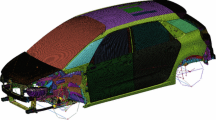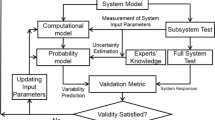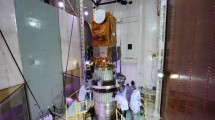Abstract
This work is devoted to the vibroacoustics of complex systems over a broad-frequency band of analysis. The considered system is composed of a complex structure coupled with an internal acoustic cavity. On one hand, the global displacements are associated with the main stiff part and on the other hand, the local displacements are associated with the preponderant vibrations of the flexible subparts. Such complex structures induce interweaving of these two types of displacements, which introduce an overlap of the usual three frequency bands (low-, medium- and high-frequency bands (LF, MF, and HF). A reduced-order computational vibroacoustic model is constructed by using a classical modal analysis with the elastic and acoustic modes. Nevertheless, the dimension of such reduced-order model (ROM) is still important when there is an overlap for each one of the three frequency bands. A multi-frequency reduced-order model is then constructed for the structure over the LF, MF, and HF bands. The strategy is based on a multilevel projection consisting in introducing three reduced-order bases that are obtained by using a spatial filtering methodology. To filter out the local displacements in the structure, a set of global shape functions is introduced. In addition, a classical ROM using acoustic modes is carried out for the acoustic cavity. Then, the coupling between the multilevel ROM and the acoustic ROM is presented. A nonparametric probabilistic modeling is then proposed to take into account the model uncertainties induced by modeling errors that increase with the frequency. The proposed approach is applied to a large-scale computational vibroacoustic model of a car.





















Similar content being viewed by others
References
Durand J, Soize C, Gagliardini L (2008) Structural-acoustic modeling of automotive vehicles in presence of uncertainties and experimental identification and validation. J Acoust Soc Am 123(3):1513–1525. https://doi.org/10.1121/1.2953316
Arnoux A, Batou A, Soize C, Gagliardini L (2013) Stochastic reduced order computational model of structures having numerous local elastic modes in low frequency dynamics. J Sound Vib 332(16):3667–3680. https://doi.org/10.1016/j.jsv.2013..02.019
Arnoux A, Soize C, Gagliardini L (2013) Reduced-order computational model for low-frequency dynamics of automobiles. Adv Mech Eng 31036:1–12. https://doi.org/10.1155/2013/310362
Gagliardini L (2014) Dispersed vibroacoustic responses of industrial products: what are we able to predict? In The 26th international conference on noise and vibration engineering (ISMA2014), Leuven, 15–17 September 2003-01-1555, 17–37
Bucher I, Braun S (1997) Left eigenvectors: extraction from measurements and physical interpretation. J Appl Mech ASME 64(1):97–105
Hansen P (1987) The truncated svd as a method for regularization. BIT Numer Math 27(4):534–553
Guyan R (1965) Reduction of stiffness and mass matrices. AIAA J 3(2):380–380
Guyan R (1992) A method for selecting master dof in dynamic substructuring using the Guyan condensation method. Comput Struct 45(5–6):941–946
Guyan R (1980) Flexural wave-propagation behavior of lumped mass approximations. Comput Struct 12(6):805–812
Chan H, Cai C, Cheung Y (1993) High convergence order finite elements with lumped mass matrix. J Sound Vib 165(2):193–207
Jensen M (1996) Convergence studies of dynamic analysis by using the finite element method with lumped mass matrix. Int J Numer Methods Eng 139(11):1879–1888
Langley R, Bremner P (1999) A hybrid method for the vibration analysis of complex structural-acoustic systems. J Acoust Soc Am 105(3):1657–1671
Ji L, Mace B, Pinnington R (2006) A mode-based approach for the mid-frequency vibration analysis of coupled long- and short-wavelength structures. J Sound Vib 289(1–2):148–170
Hahn Y, Kikuchi N (2005) Identification of global modeshape from a few nodal eigenvectors using simple free-form deformation. Eng Comput 21(2):115–128
Guyader J (2009) Characterization and reduction of dynamic models of vibrating systems with high modal density. J Sound Vib 328(4–5):488–506
Guyader J (1990) Modal sampling method for the vibration study of systems of high modal density. J Acoust Soc Am 88(5):2269–2276
Noor A, Anderson M, Greene W (1978) Continuum models for beam- and platelike-lattice structures. AIAA J 16(12):1219–1228
Planchard J (1985) Vibrations of nuclear fuel assemblies: a simplified model. Nucl Eng Des 86(3):383–391
Sigrits J, Broc D (2008) Dynamic analysis of a tube bundle with fluid-structure interaction modelling using a homogenisation method. Comput Methods Appl Mech Eng 197(9–12):1080–1099
Craig R (1985) A Review of time domain and frequency domain component mode synthesis method in combined experimental-analytical modeling of dynamic structural systems. D.R. Martinez and A.K. Miller, New York
de Klerk D, Rixen D, Voormeeren S (2008) General framework for dynamic substructuring: history, review, and classification of techniques. AIAA J 4:1169–1181
Leung A (1993) Dynamic stiffness and substructures. Springer, Berlin
Ohayon R, Soize C, Sampaio R (2014) Variational-based reduced-order model in dynamic substructuring of coupled structures through a dissipative physical interface: recent advances. Arch Comput Methods Eng 21(3):321–329. https://doi.org/10.1007/s11831-014-9107-y
Argyris J, Kelsey S (1959) The analysis of fuselages of arbitrary cross-section and taper: a DSIR sponsored research program on the development and application of the matrix force method and the digital computer. Aircr Eng Aerosp Technol 31(3):62–74
Przemieniecki J (1963) Matrix structural analysis of substructures. AIAA J 1(1):138–147
Irons B (1965) Structural eigenvalue problems—elimination of unwanted variables. AIAA J 3(5):961–962
Hurty W (1960) Vibrations of structural systems by component mode synthesis. J Eng Mech ASCE 86(4):51–70
Hurty W (1965) Dynamic analysis of structural systems using component modes. AIAA J 3(4):678–685
Craig R, Bampton M (1968) Coupling of substructures for dynamic analyses. AIAA J 6(7):1313–1319
Bathe K, Gracewski S (1981) On nonlinear dynamic analysis using substructuring and mode superposition. Comput Struct 13(5):699–707
Farhat C, Geradin M (1994) On a component mode synthesis method and its application to incompatible substructures. Comput Struct 51(5):459–473
Meirovitch L, Hale A (1981) On the substructure synthesis method. AIAA J 19(7):940–947
Meirovitch L, Kwak M (1991) Rayleigh-ritz based substructure synthesis for flexible multibody systems. AIAA J 29(10):1709–1719
Voormeeren S, van der Valk P, Rixen D (2011) Generalized methodology for assembly and reduction of component models for dynamic substructuring. AIAA J 49(5):1010–1020
Voormeeren S, van der Valk P, Rixen D (1971) Vibration analysis of structures by component mode substitution. AIAA J 9(7):1255–1261
R.MacNeal,Vibration analysis of structures by component mode substitution, Computers & Structures 1 (4)(1971) 581–601
Rubin S (1975) Improved component-mode representation for structural dynamic analysis. AIAA J 13(8):995–1006
Markovic D, Park K, Ibrahimbegovic A (2007) Reduction of substructural interface degrees of freedom in flexibility-based component mode synthesis. Int J Numer Methods Eng 70(2):163–180
Ohayon R, Sampaio R, Soize C (1997) Dynamic substructuring of damped structures using singular value decomposition. J Appl Mech ASME 64(2):292–298
Park K, Park Y (2004) Dynamic substructuring of damped structures using singular value decomposition. AIAA J 42(6):1236–1245. https://doi.org/10.1115/1.2787306
Rixen D (2004) A dual Craig–Bampton method for dynamic substructuring. J Comput Appl Math 168(1–2):383–391
Soize C (2017) Uncertainty quantification. An accelerated course with advanced applications in computational engineering. Springer, New York. https://doi.org/10.1007/978-3-319-54339-0
Ibrahim R (1985) Parametric random vibration. Wiley, New York
Beck J, Katafygiotis L (1998) Updating models and their uncertainties—I: Bayesian statistical framework. J Eng Mech ASCE 124(4):455–461
Mace R, Worden W, Manson G (2005) Uncertainty in structural dynamics. J Sound Vib 288(3):431–790
Schuëller G, Pradlwarter H (2009) Uncertain linear systems in dynamics: retrospective and recent developments by stochastic approaches. Eng Struct 31(11):2507–2517
Soize C (2013) Stochastic modeling of uncertainties in computational structural dynamics—recent theoretical advances. J Sound Vib 332(10):2379–2395. https://doi.org/10.1016/j.jsv.2011.10.010
Schuëller G (2005) Computational methods in stochastic mechanics and reliability analysis. Comput Methods Appl Mech Eng 194(12–16):1251–1795
Schuëller G (2005) Uncertainties in structural mechanics and analysis—computational methods. Comput Struct 83(14):1031–1150
Schuëller G (2006) Developments in stochastic structural mechanics. Arch Appl Mech 75(10–12):755–773
Deodatis G, Spanos P (2008) Computational stochastic mechanics. Probab Eng Mech 23(2–3):103–346
Ghanem R (1991) Stochastic finite elements: a spectral approach, Revised. Dover Publications, New York
Soize C, Ghanem R (2004) Physical systems with random uncertainties: chaos representations with arbitrary probability measure. SIAM J Sci Comput 26(2):395–410. https://doi.org/10.1137/S1064827503424505
Le Maitre O, Knio O (2010) Spectral methods for uncerainty quantification with applications to computational fluid dynamics. Springer, Heidelberg
Ghanem R, Higdon D, Owhadi H (2017) Handbook of uncertainty quantification. Springer, Cham
Bui-Thanh T, Willcox K, Ghattas O (2008) Parametric reduced-order models for probabilistic analysis of unsteady aerodynamic applications. AIAA J 46(10):2520–2529
Degroote J, Vierendeels J, Willcox K (2010) Interpolation among reduced-order matrices to obtain parameterized models for design, optimization and probabilistic analysis. Int J Numer Methods Eng 63(2):207–230
Marzouk Y, Najm H, Rahn L (2007) Stochastic spectral methods for efficient Bayesian solution of inverse problems. J Comput Phys 224(2):560–586
Galbally D, Fidkowski K, Willcox K, Ghattas O (2010) Non-linear model reduction for uncertainty quantification in large scale inverse problems. Int J Numer Methods Eng 81(12):1581–1608
Lieberman C, Willcox K, Ghattas O (2010) Parameter and state model reduction for large scale statistical inverse problems. SIAM J Sci Comput 32(5):2523–2542
Nouy A, Soize C (2014) Random field representations for stochastic elliptic boundary value problems and statistical inverse problems. Eur J Appl Math 25(3):339–373. https://doi.org/10.1017/S0956792514000072
Cui T, Marzouk Y, Willcox K (2015) Data-driven model reduction for the Bayesian solution of inverse problems. Int J Numer Methods Eng 102(5):966–990
Soize C (2017) Random vectors and random fields in high dimension: parametric model-based representation, identification from data, and inverse problems. In: Ghanem R, Higdon D, Owhadi H (eds) Handbook of uncertainty quantification, vol 2, Springer, Cham, Ch. 26, pp 883–936. https://doi.org/10.1007/978-3-319-11259-6_30-1
Soize C (2000) A nonparametric model of random uncertainties for reduced matrix models in structural dynamics. Probab Eng Mech 15(3):277–299. https://doi.org/10.1016/S0266-8920(99)00028-4
Shannon C (1948) A mathematical theory of communication. Bell Syst Tech J 27(3):379–423
Jaynes E (1957) Information theory and statistical mechanics. Phys Rev 106(4):620
Mignolet M, Soize C (2008) Nonparametric stochastic modeling of linear systems with prescribed variance of several natural frequencies. Probab Eng Mech 23(2–3):267–278. https://doi.org/10.1016/j.probengmech.2007.12.027
Soize C (2017) Random matrix models and nonparametric method for uncertainty quantification. In: Ghanem R, Higdon D, Owhadi H (eds) Handbook of uncertainty quantification, vol 1, Springer, Cham, pp 219–287. https://doi.org/10.1007/978-3-319-11259-6_5-1
Chen C, Duhamel D, Soize C (2006) Probabilistic approach for model and data uncertainties and its experimental identification in structural dynamics: case of composite sandwich panels. J Sound Vib 294(1–2):64–81. https://doi.org/10.1016/j.jsv.2005.10.013
Capillon R, Desceliers C, Soize C (2016) Uncertainty quantification in computational linear structural dynamics for viscoelastic composite structures. Comput Methods Appl Mech Eng 305:154–172
Soize C, Chebli H (2003) Random uncertainties model in dynamic substructuring using a nonparametric probabilistic model. J Eng Mech ASCE 129(4):449–457. https://doi.org/10.1061/(ASCE)0733-9399(2003)129:4(449)
Mignolet M, Soize C, Avalos J (2013) Nonparametric stochastic modeling of structures with uncertain boundary conditions/coupling between substructures. AIAA J 51(6):1296–1308. https://doi.org/10.2514/1.J051555
Arnst M, Clouteau D, Chebli H, Othman R, Degrande G (2006) A non-parametric probabilistic model for ground-borne vibrations in buildings. Probab Eng Mech 21(1):18–34
Ohayon RCS (2014) Advanced computational vibroacoustics—reduced-order models and uncertainty quantification. Cambridge University Press, New York
Capiez-Lernout E, Soize C (2008) Robust design optimization in computational mechanics. J Appl Mech ASME 75(2):1–11. https://doi.org/10.1115/1.2775493
Arnst M, Soize C (2019) Identification and sampling of Bayesian posteriors of high-dimensional symmetric positive-definite matrices for data-driven updating of computational models. Comput Methods Appl Mech Eng 352:300–323. https://doi.org/10.1016/j.cma.2019.04.025
Mignolet M, Soize C (2008) Stochastic reduced order models for uncertain geometrically nonlinear dynamical systems. Comput Methods Appl Mech Eng 197(45–48):3951–3963. https://doi.org/10.1016/j.cma.2008.03.032
Capiez-Lernout E, Soize C, MP M (2014) Post-buckling nonlinear static and dynamical analyses of uncertain cylindrical shells and experimental validation. Comput Methods Appl Mech Eng 271(1):210–230
Soize C, Farhat C (2016) Uncertainty quantification of modeling errors for nonlinear reduced-order computational models using a nonparametric probabilistic approach. Int J Numer Methods Eng 30(2016):96
Ezvan O, Batou A, Soize C (2015) Multilevel reduced-order computational model in structural dynamics for the low-and medium-frequency ranges. Comput Struct 160:111–125. https://doi.org/10.1016/j.compstruc.2015.08.007
Ezvan O, Batou A, Soize C, Gagliardini L (2017) Multilevel model reduction for uncertainty quantification in computational structural dynamics. Comput Mech 59(2):219–246. https://doi.org/10.1007/s00466-016-1348-1
Ohayon R, Soize C (1998) Structural acoustics and vibration. Academic Press, San Diego
Author information
Authors and Affiliations
Corresponding author
Additional information
Publisher's Note
Springer Nature remains neutral with regard to jurisdictional claims in published maps and institutional affiliations.
Rights and permissions
About this article
Cite this article
Reyes, J., Desceliers, C., Soize, C. et al. Multi-frequency model reduction for uncertainty quantification in computational vibroacoutics. Comput Mech 69, 661–682 (2022). https://doi.org/10.1007/s00466-021-02109-y
Received:
Accepted:
Published:
Issue Date:
DOI: https://doi.org/10.1007/s00466-021-02109-y




